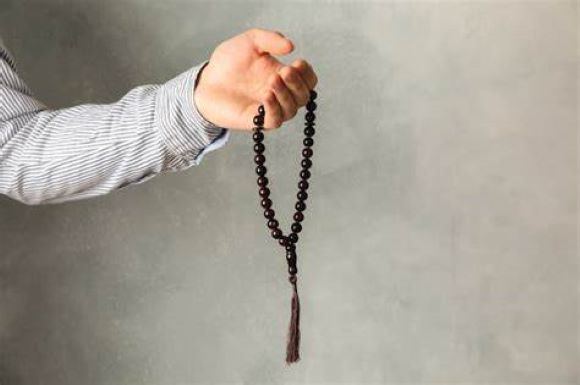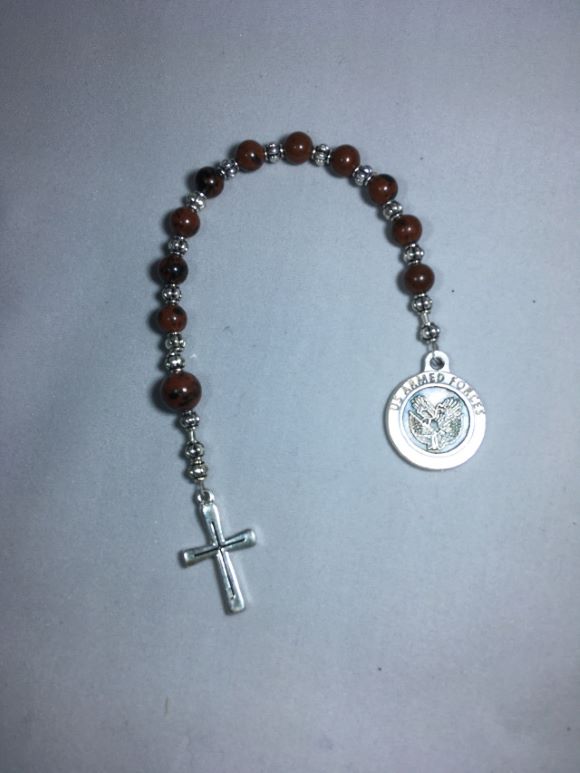What the Heck is a Chaplet, Anyway?
I’m asked on a regular basis by many non-Catholics what a rosary is and why we pray it. Many times, this question is followed by a scree of derogatory comments like, “Repetitious prayer is evil and forbidden by the Bible!” or, “You’re worshiping Mary, not God!” I’ll get to those points in a bit.
A Chaplet
A chaplet is a vocal or intimate personal prayer— prayed with a string or circle of beads or on a single short strand. The prayers can be prayed in petition (asking God for something), adoration (of God), thanksgiving, or reparation (asking for forgiveness). Typically, there are:
- introductory prayers
- a sequence of a set of prayers
- repetition of that sequence
- closing prayers
These prayers are typically very well-known so the person’s mind can easily drift into a state of meditation, and the prayers are generally put in sets of seven to ten prayers, then grouped into sequences of five to twenty. The most well-known chaplet prayer is the rosary, but there are many, many others. Some devotions may be to St. Joseph, The Divine Mercy, St. Jude, St. Michael, etc. There is no restriction! You are free, in fact encouraged, to create your own devotion.

How Old is the Chaplet?
Chaplet prayers have been around for thousands of years. The Jews had a system of beads dating back to the time of Solomon that they would run through their fingers while praying the Shema from Deuteronomy 6: 4-9:
Hear, O Israel! The LORD is our God, the LORD alone! Therefore, you shall love the LORD, your God, with your whole heart, and with your whole being, and with your whole strength. Take to heart these words which I command you today. Keep repeating them to your children. Recite them when you are at home and when you are away, when you lie down and when you get up. Bind them on your arm as a sign* and let them be as a pendant on your forehead. Write them on the doorposts of your houses and on your gates.
The full Shema is 21 verses long and was prayed once daily, while the shorter version (above) was prayed several times a day.

Other cultures and religions have also prayed a form of chaplet for over a thousand years. The Asian-based philosophies of Daoism, Buddhism, and Hinduism, as well as Islam, all have chaplet prayers. In every case, the chaplet prayers are used to bring the heart, mind, and soul into a balanced, calm space that allows one to pray and meditate.
What Do I Do When I Pray the Chaplet?
The main purpose of a chaplet prayer is to meditate. The prayers are set up in sequences that allow the balanced mind, heart, and soul to meditate on and contemplate certain scenes in Jesus’s life. Chaplets are not used for worshiping saints! Worship is for God alone. The prayers said allow one to see in their mind’s eye and heart the scene from a certain perspective. If we are saying a rosary, we are saying the Hail Mary prayer ten times in a row and seeing Jesus’s life through Mary’s eyes. If we are praying the Divine Mercy, we are praying the words given to St. Faustina by Jesus in a vision in the 1930’s. There are many different forms and patrons of chaplets.
Each chaplet has its own prayers that become the “timekeeper” for the meditative prayer. As you are praying the prayer, your mind is focused on a scene in the life of Jesus and asking God for something (petition), or adoring, or thanking God, or asking for forgiveness for your or other’s sins. At the same time, your fingers are holding one of the beads on the string of chaplet beads. As you begin the next prayer, your fingers move to the next bead in the string. When your fingers come to a break in the beads, you bring the focused meditation on that scene to a close, say a unifying prayer, and begin the next focused meditation on a different part of Jesus’s life.
“But this is Repetitious Prayer!”
In a word, yes, it is. But the repetitious prayer that Jesus warned of in Matthew 6: 7 is one of “heaping up empty phrases…” It was common in His day for pagans to mention every god of their pantheon in a perfect sequence so as not to irritate or hack off the local deities. They would start by naming the smallest gods in the area, then proceed to the bigger and greater ones, culminating with the highest-named god of the area. If the person doing the vocal prayer missed even one of the slighter gods in the area, they would have to start all over. These were, as Jesus put it, “heaping up empty phrases” by simply naming the deities of the area.
For those still thinking that a chaplet or the repetition of a prayer is bad, need I remind you that even the Disciples repeated prayers, as do every Christian religion? The Lord’s Prayer is the most repeated prayer in the Christian world! If you fully embrace not ever repeating a prayer, you need to never pray the Lord’s Prayer ever again.
“The Rosary is Worshiping Mary!”
In no way does the rosary worship Mary. The Hail Mary prayer is used as the “timekeeper,” and we are seeing the life of her Son, Jesus, through her eyes. In every one of the guided meditations of the rosary, Mary is pointing to Jesus and telling us to do what He says, or “Follow Him.” We are never told to do or follow what she says or does.
The words of the Hail Mary prayer are Biblical. “Hail Mary, full of Grace! The Lord is with you!” (Luke 1: 28). “Blessed art thou among women and blessed is the fruit of your womb [Jesus].” (Luke 1: 42). The rest of the prayer is a petition, or asking Mary as a friend, to go to her Son on our behalf in prayer. “Holy Mary, mother of God, pray for us now and at the hour of our death.”
Do I Have to Pray a Chaplet Prayer?
No. All chaplet prayers are private and personal devotions that you can choose to, or not to do. They are not a part of the “have-to’s” of the Catholic church. But chaplets are a very rich and rewarding way to spend time praying and communicating with Jesus. A good resource for chaplet prayers is at: A Treasure of 59 Chaplet Devotions (catholicdoors.com). Or, if so moved, come up with your own version of a devotional prayer that leads you into a deeper meditative or contemplative prayer time. You’ll be glad you did.














